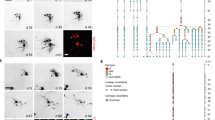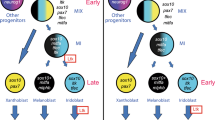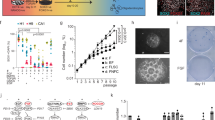Abstract
Adult stem cells are characterized by self-renewal and multilineage differentiation, and these properties seem to be regulated by signals from adjacent differentiated cell types and by extracellular matrix molecules, which collectively define the stem cell “niche.” Self-renewal is essential for the lifelong persistence of stem cells, but its regulation is poorly understood. In the mammalian brain, neurogenesis persists in two germinal areas, the subventricular zone (SVZ) and the hippocampus, where continuous postnatal neuronal production seems to be supported by neural stem cells (NSCs). Here we show that pigment epithelium–derived factor (PEDF) is secreted by components of the murine SVZ and promotes self-renewal of adult NSCs in vitro. In addition, intraventricular PEDF infusion activated slowly dividing stem cells, whereas a blockade of endogenous PEDF decreased their cycling. These data demonstrate that PEDF is a niche-derived regulator of adult NSCs and provide evidence for a role for PEDF protein in NSC maintenance.
This is a preview of subscription content, access via your institution
Access options
Subscribe to this journal
Receive 12 print issues and online access
$209.00 per year
only $17.42 per issue
Buy this article
- Purchase on Springer Link
- Instant access to full article PDF
Prices may be subject to local taxes which are calculated during checkout







Similar content being viewed by others
References
Doetsch, F. A niche for adult neural stem cells. Curr. Opin. Genet. Dev. 13, 543–550 (2003).
Palmer, T.D., Takahashi, J. & Gage, F.H. The adult rat hippocampus contains primordial neural stem cells. Mol. Cell. Neurosci. 8, 389–404 (1997).
Reynolds, B.A. & Weiss, S. Generation of neurons and astrocytes from isolated cells of the adult mammalian central nervous system. Science 255, 1707–1710 (1992).
Morshead, C.M., Craig, C.G. & van der Kooy, D. In vivo clonal analyses reveal the properties of endogenous neural stem cell proliferation in the adult mammalian forebrain. Development 125, 2251–2261 (1998).
Doetsch, F., Caille, I., Lim, D.A., Garcia-Verdugo, J.M. & Alvarez-Buylla, A. Subventricular zone astrocytes are neural stem cells in the adult mammalian brain. Cell 97, 703–716 (1999).
Garcia, A.D., Doan, N.B., Imura, T., Bush, T.G. & Sofroniew, M.V. GFAP-expressing progenitors are the principal source of constitutive neurogenesis in adult mouse forebrain. Nat. Neurosci. 7, 1233–1241 (2004).
Doetsch, F., Garcia-Verdugo, J.M. & Alvarez-Buylla, A. Cellular composition and three-dimensional organization of the subventricular germinal zone in the adult mammalian brain. J. Neurosci. 17, 5046–5061 (1997).
Ferron, S. et al. Telomere shortening and chromosomal instability abrogates proliferation of adult but not embryonic neural stem cells. Development 131, 4059–4070 (2004).
Palmer, T.D., Willhoite, A.R. & Gage, F.H. Vascular niche for adult hippocampal neurogenesis. J. Comp. Neurol. 425, 479–494 (2000).
Capela, A. & Temple, S. LeX/ssea-1 is expressed by adult mouse CNS stem cells, identifying them as nonependymal. Neuron 35, 865–875 (2002).
Leventhal, C., Rafii, S., Rafii, D., Shahar, A. & Goldman, S.A. Endothelial trophic support of neuronal production and recruitment from the adult mammalian subependyma. Mol. Cell. Neurosci. 13, 450–464 (1999).
Shingo, T., Sorokan, S.T., Shimazaki, T. & Weiss, S. Erythropoietin regulates the in vitro and in vivo production of neuronal progenitors by mammalian forebrain neural stem cells. J. Neurosci. 21, 9733–9743 (2001).
Jin, K. et al. Vascular endothelial growth factor (VEGF) stimulates neurogenesis in vitro and in vivo. Proc. Natl. Acad. Sci. USA 99, 11946–11950 (2002).
Louissaint, A., Jr., Rao, S., Leventhal, C. & Goldman, S.A. Coordinated interaction of neurogenesis and angiogenesis in the adult songbird brain. Neuron 34, 945–960 (2002).
Shen, Q. et al. Endothelial cells stimulate self-renewal and expand neurogenesis of neural stem cells. Science 304, 1338–1340 (2004).
Tombran-Tink, J., Chader, G.G. & Johnson, L.V. PEDF: a pigment epithelium-derived factor with potent neuronal differentiative activity. Exp. Eye Res. 53, 411–414 (1991).
Steele, F.R., Chader, G.J., Johnson, L.V. & Tombran-Tink, J. Pigment epithelium-derived factor: neurotrophic activity and identification as a member of the serine protease inhibitor gene family. Proc. Natl. Acad. Sci. USA 90, 1526–1530 (1993).
Becerra, S.P., Sagasti, A., Spinella, P. & Notario, V. Pigment epithelium-derived factor behaves like a noninhibitory serpin. Neurotrophic activity does not require the serpin reactive loop. J. Biol. Chem. 270, 25992–25999 (1995).
Aparicio, S., Sawant, S., Lara, N., Barnstable, C.J. & Tombran-Tink, J. Expression of angiogenesis factors in human umbilical vein endothelial cells and their regulation by PEDF. Biochem. Biophys. Res. Commun. 326, 387–394 (2005).
Kozaki, K. et al. Isolation, purification, and characterization of a collagen-associated serpin, caspin, produced by murine colon adenocarcinoma cells. J. Biol. Chem. 273, 15125–15130 (1998).
Meyer, C., Notari, L. & Becerra, S.P. Mapping the type I collagen-binding site on pigment epithelium-derived factor. Implications for its antiangiogenic activity. J. Biol. Chem. 277, 45400–45407 (2002).
Bilak, M.M. et al. Identification of the neuroprotective molecular region of pigment epithelium-derived factor and its binding sites on motor neurons. J. Neurosci. 22, 9378–9386 (2002).
Araki, T., Taniwaki, T., Becerra, S.P., Chader, G.J. & Schwartz, J.P. Pigment epithelium-derived factor (PEDF) differentially protects immature but not mature cerebellar granule cells against apoptotic cell death. J. Neurosci. Res. 53, 7–15 (1998).
Dawson, D.W. et al. Pigment epithelium-derived factor: a potent inhibitor of angiogenesis. Science 285, 245–248 (1999).
Sugita, Y., Becerra, S.P., Chader, G.J. & Schwartz, J.P. Pigment epithelium-derived factor (PEDF) has direct effects on the metabolism and proliferation of microglia and indirect effects on astrocytes. J. Neurosci. Res. 49, 710–718.
Pignolo, R.J., Francis, M.K., Rotenberg, M.O. & Cristofalo, V.J. Putative role for EPC-1/PEDF in the G0 growth arrest of human diploid fibroblasts. J. Cell. Physiol. 195, 12–20 (2003).
Tombran-Tink, J. & Barnstable, C.J. PEDF: a multifaceted neurotrophic factor. Nat. Rev. Neurosci. 4, 628–636 (2003).
Ortego, J., Escribano, J., Becerra, S.P. & Coca-Prados, M. Gene expression of the neurotrophic pigment epithelium-derived factor in the human ciliary epithelium. Synthesis and secretion into the aqueous humor. Invest. Ophthalmol. Vis. Sci. 37, 2759–2767 (1996).
Bertrand, N., Castro, D.S. & Guillemot, F. Proneural genes and the specification of neural cell types. Nat. Rev. Neurosci. 3, 517–530 (2002).
Ohtsuka, T., Sakamoto, M., Guillemot, F. & Kageyama, R. Roles of the basic helix-loop-helix genes Hes1 and Hes5 in expansion of neural stem cells of the developing brain. J. Biol. Chem. 276, 30467–30474 (2001).
Hitoshi, S. et al. Notch pathway molecules are essential for the maintenance, but not the generation, of mammalian neural stem cells. Genes Dev. 16, 846–858 (2002).
Parras, C.M. et al. Mash1 specifies neurons and oligodendrocytes in the postnatal brain. EMBO J. 23, 4495–4505 (2004).
Bylund, M., Andersson, E., Novitch, B.G. & Muhr, J. Vertebrate neurogenesis is counteracted by Sox1–3 activity. Nat. Neurosci. 6, 1162–1168 (2003).
Graham, V., Khudyakov, J., Ellis, P. & Pevny, L. SOX2 functions to maintain neural progenitor identity. Neuron 39, 749–765 (2003).
Ferri, A.L. et al. Sox2 deficiency causes neurodegeneration and impaired neurogenesis in the adult mouse brain. Development 131, 3805–3819 (2004).
Alberdi, E., Aymerich, M.S. & Becerra, S.P. Binding of pigment epithelium-derived factor (PEDF) to retinoblastoma cells and cerebellar granule neurons. Evidence for a PEDF receptor. J. Biol. Chem. 274, 31605–31612 (1999).
Song, H., Stevens, C.F. & Gage, F.H. Astroglia induce neurogenesis from adult neural stem cells. Nature 417, 39–44 (2002).
Lim, D.A. & Alvarez-Buylla, A. Interaction between astrocytes and adult subventricular zone precursors stimulates neurogenesis. Proc. Natl. Acad. Sci. USA 96, 7526–7531 (1999).
Craig, C.G. et al. In vivo growth factor expansion of endogenous subependymal neural precursor cell populations in the adult mouse brain. J. Neurosci. 16, 2649–2658 (1996).
Kuhn, H.G., Winkler, J., Kempermann, G., Thal, L.J. & Gage, F.H. Epidermal growth factor and fibroblast growth factor-2 have different effects on neural progenitors in the adult rat brain. J. Neurosci. 17, 5820–5829 (1997).
Doetsch, F., Petreanu, L., Caille, I., Garcia-Verdugo, J.M. & Alvarez-Buylla, A. EGF converts transit amplifying neurogenic precursors in the adult brain into multipotent stem cells. Neuron 36, 1021–1034 (2002).
Zigova, T., Pencea, V., Wiegand, S.J. & Luskin, M.B. Intraventricular administration of BDNF increases the number of newly generated neurons in the adult olfactory bulb. Mol. Cell. Neurosci. 11, 234–245 (1998).
Mercier, F., Kitasako, J.T. & Hatton, G.I. Anatomy of the brain neurogenic zones revisited: fractones and the fibroblast/macrophage network. J. Comp. Neurol. 451, 170–188 (2002).
Garcion, E., Halilagic, A., Faissner, A. & ffrench-Constant, C. Generation of an environmental niche for neural stem cell development by the extracellular matrix molecule tenascin C. Development 131, 3423–3432 (2004).
Molofsky, A.V., Pardal, R. & Morrison, S.J. Diverse mechanisms regulate stem cell self-renewal. Curr. Opin. Cell Biol. 16, 700–707 (2004).
Herrera, D.G., Garcia-Verdugo, J.M. & Alvarez-Buylla, A. Adult-derived neural precursors transplanted into multiple regions in the adult brain. Ann. Neurol. 46, 867–877 (1999).
Acknowledgements
We thank C. Hermenegildo for help with cultures of umbilical cord vascular cells, F. Sánchez-Madrid for antibodies to V-cadherin and M. Cano-Jaimez and I. Marín for reading the manuscript. This work was supported by grants from the Ministerio de Educación y Ciencia (MEC; SAF2002-03355) and Ministerio de Sanidad y Consumo (G03/167 and 210) to I.F., and from the Ministerio de Ciencia y Tecnología (SAF2002-03086), Consejería de Sanidad de la Junta de Comunidades de Castilla-La Mancha (GC-03-014 and 02021-00) and Spanish Network for Neurological Research (CIEN, C03/06) to J.E. C.R.-C. was supported by a MEC Postdoctoral Fellowship, and C.A.-A. and J.D.A.-A. are predoctoral fellows of the MEC-FPU (Formación de Profesorado Universitairo) Program and the Consejeria de Sanidad de Castilla-La Mancha, Spain, respectively. P.S. and H.M. are investigators of the Programa Ramón y Cajal from the MEC.
Author information
Authors and Affiliations
Corresponding author
Ethics declarations
Competing interests
The authors of the paper are filing a patent on the effect of PEDF on stem cell renewal.
Rights and permissions
About this article
Cite this article
Ramírez-Castillejo, C., Sánchez-Sánchez, F., Andreu-Agulló, C. et al. Pigment epithelium–derived factor is a niche signal for neural stem cell renewal. Nat Neurosci 9, 331–339 (2006). https://doi.org/10.1038/nn1657
Received:
Accepted:
Published:
Issue Date:
DOI: https://doi.org/10.1038/nn1657
This article is cited by
-
Outcomes of the 2019 hydrocephalus association workshop, "Driving common pathways: extending insights from posthemorrhagic hydrocephalus"
Fluids and Barriers of the CNS (2023)
-
Cerebral Vascular Toxicity of Antiretroviral Therapy
Journal of Neuroimmune Pharmacology (2021)
-
Angiocrine endothelium: from physiology to cancer
Journal of Translational Medicine (2020)
-
PEDF promotes the repair of bone marrow endothelial cell injury and accelerates hematopoietic reconstruction after bone marrow transplantation
Journal of Biomedical Science (2020)
-
Adult Neurogenesis in the Subventricular Zone and Its Regulation After Ischemic Stroke: Implications for Therapeutic Approaches
Translational Stroke Research (2020)



